2018 | Starbucks
A Dataviz Mural for Starbucks' First Store in Italy
Data Art, Physical Installation, and Augmented Reality Experience
A business trip to Italy and a taste of Italian espresso culture inspired Starbucks CEO Howard Schultz to transform the brand from a coffee purveyor into a coffeehouse. As the corporation prepared to open its first–ever location in the country, representatives contacted Accurat to mark the momentous occasion with a design set in stone—literally.
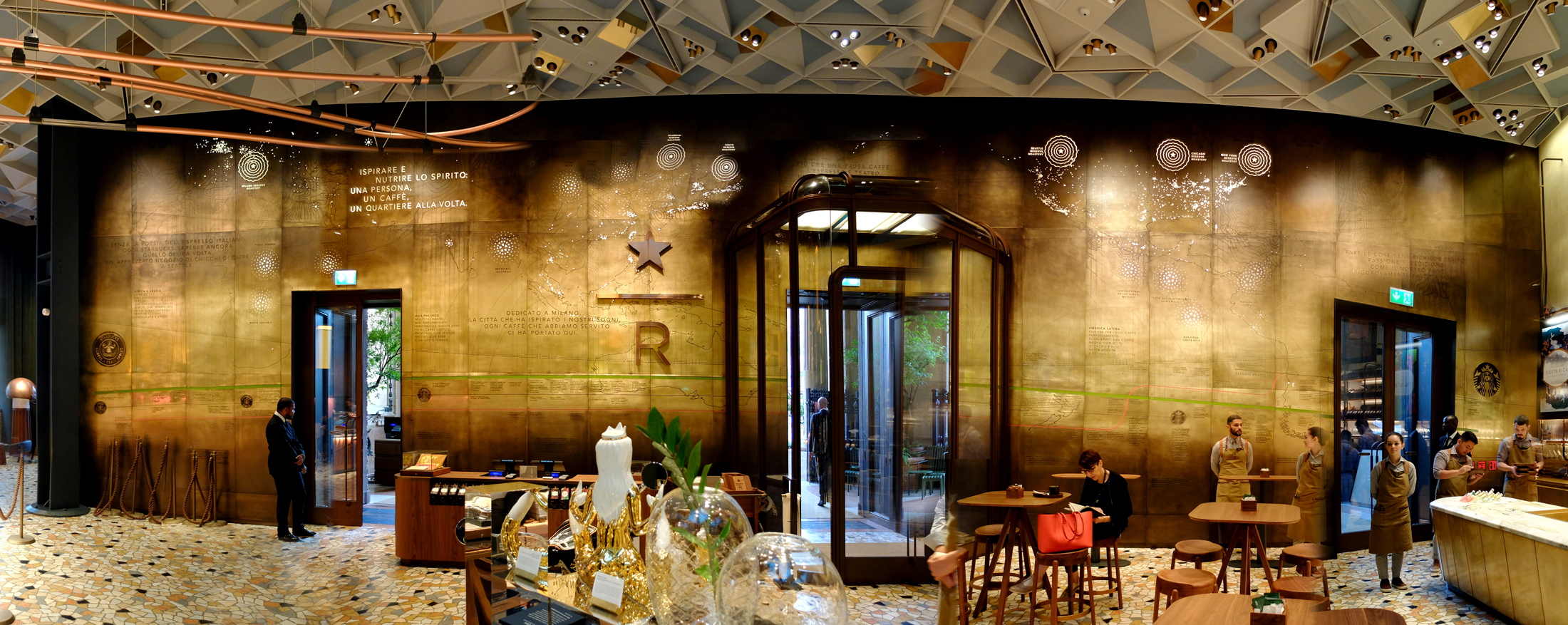
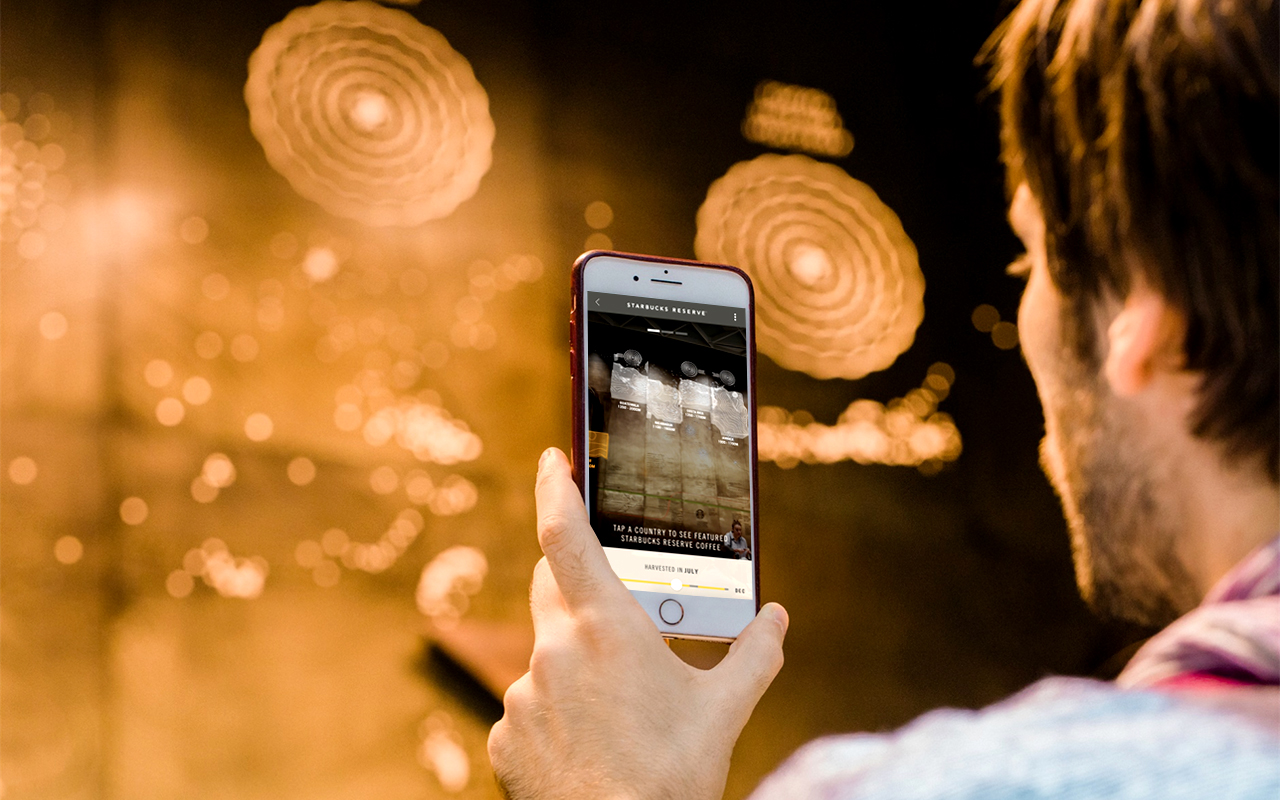
Photo credit: Joshua Trujillo
Brief
Distinct from ordinary locations, Starbucks Reserve Roasteries are active sites for experimentation. In addition to ordering from menus filled with local delicacies, visitors can see firsthand how coffee artisans brew, infuse, and roast new blends. After opening locations in Seattle and Shanghai, Starbucks executives planned to open the third Reserve Roastery in the world in the historic Poste building in Milan’s Piazza Cordusio. It was essential that the new location blend into the old–world environs even as it served as a hub for innovation. Representatives from Starbucks Creative Global Design & Innovation commissioned Accurat to build a data–driven installation that recounted the brand's Milanese origins with an eye toward the future.
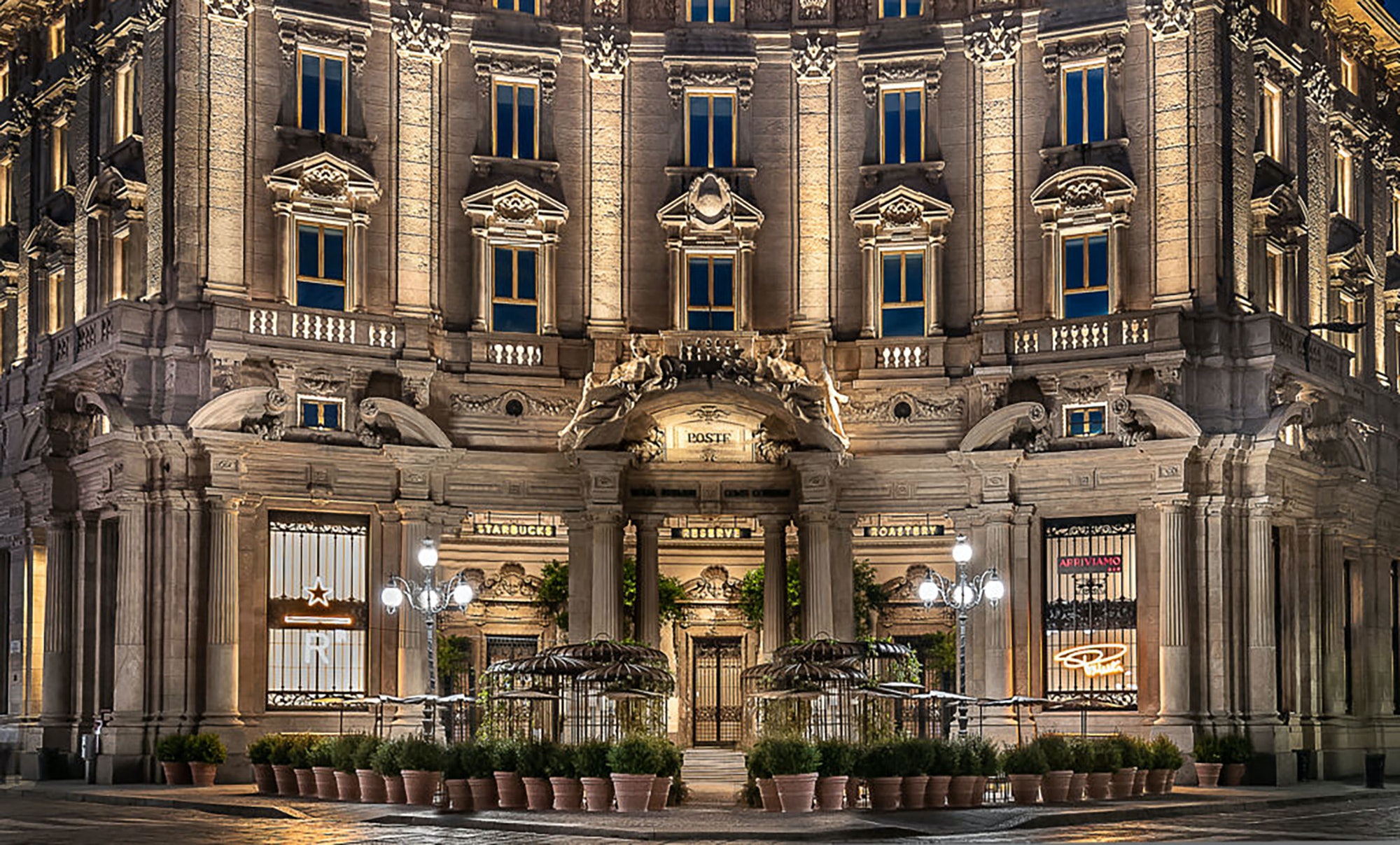
The historic Poste building, in Milan's Piazza Cordusio.
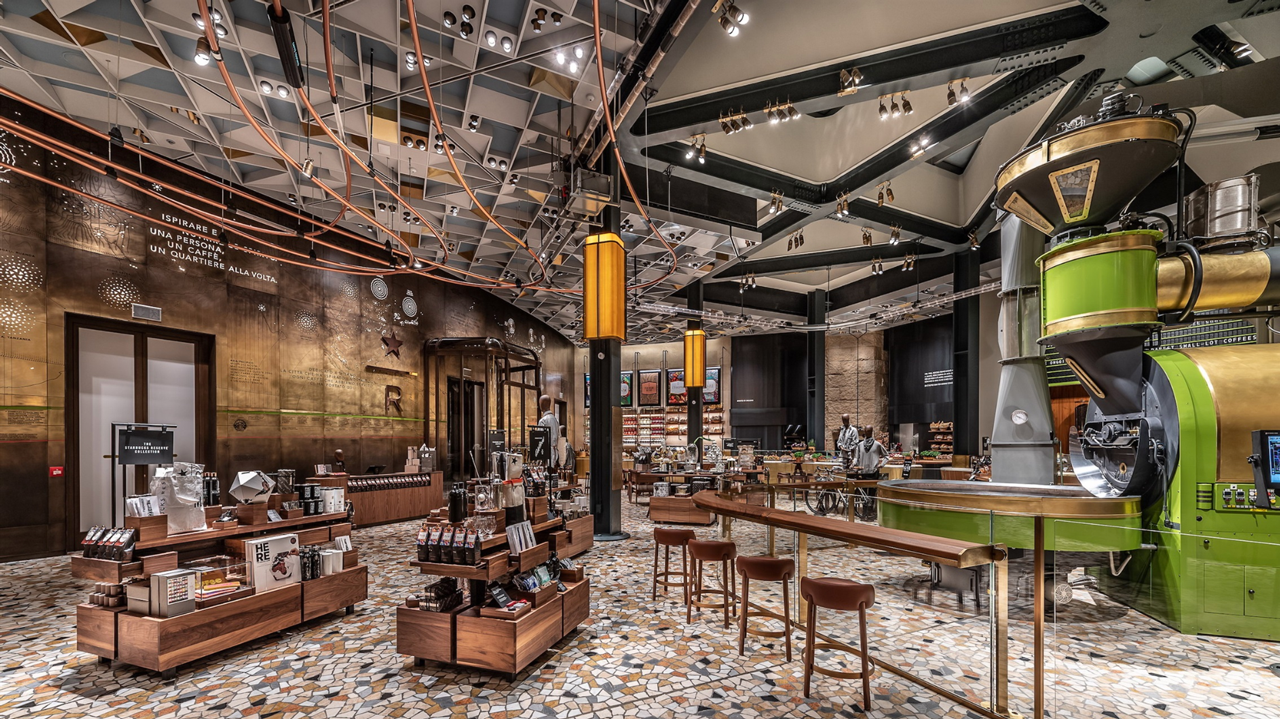
Remodeled interior.
Process
We learned the details of the Howard Schultz anecdote from executives. The role that Milan had played in Starbucks' evolution would be the main narrative through line for our data visualization.
In tandem, we communicated with architects and local artisans to determine how to integrate a multilayered design into the Roastery’s interior aesthetic. We decided to carve it into the walls, in a brass–engraved visualization that would take visitors on a journey from Starbucks’ Seattle origins to its latest international outpost.
The logistics of designing for an earthen material meant to be engraved, perforated, and polished presented a learning curve that we navigated by working side–by–side with craftspeople, spending plenty of time at manufacturing facilities and the Roastery construction site. To deduce the best way to visualize the narrative, we tested several layering techniques on a small–scale with brass tiles. We assessed the legibility and placement of elements with vinyl mocks hung on the wall where the visualization would appear.
From the beginning, it was clear that even the floor–to–ceiling, wall–to–wall brass canvas couldn’t contain the full story. While we worked on the production of the brass mural, we conceived of an augmented reality experience that would enrich the physical one. Again, the material presented unique challenges. Ordinary image recognition technology wouldn’t work on the back–lit, curved and reflective surface. In collaboration with our partners at Monogrid—a Florence–based digital interactive studio—we determined the positions from which visitors were most likely to aim the app. From these views, we segmented the wall into frames, within which we identified the most compelling visual components to act as markers. Calibrating the size and dimensions of them, we divided the wall into portions to create a seamless 3D tracking of the surface.
In tandem, we communicated with architects and local artisans to determine how to integrate a multilayered design into the Roastery’s interior aesthetic. We decided to carve it into the walls, in a brass–engraved visualization that would take visitors on a journey from Starbucks’ Seattle origins to its latest international outpost.
The logistics of designing for an earthen material meant to be engraved, perforated, and polished presented a learning curve that we navigated by working side–by–side with craftspeople, spending plenty of time at manufacturing facilities and the Roastery construction site. To deduce the best way to visualize the narrative, we tested several layering techniques on a small–scale with brass tiles. We assessed the legibility and placement of elements with vinyl mocks hung on the wall where the visualization would appear.
From the beginning, it was clear that even the floor–to–ceiling, wall–to–wall brass canvas couldn’t contain the full story. While we worked on the production of the brass mural, we conceived of an augmented reality experience that would enrich the physical one. Again, the material presented unique challenges. Ordinary image recognition technology wouldn’t work on the back–lit, curved and reflective surface. In collaboration with our partners at Monogrid—a Florence–based digital interactive studio—we determined the positions from which visitors were most likely to aim the app. From these views, we segmented the wall into frames, within which we identified the most compelling visual components to act as markers. Calibrating the size and dimensions of them, we divided the wall into portions to create a seamless 3D tracking of the surface.
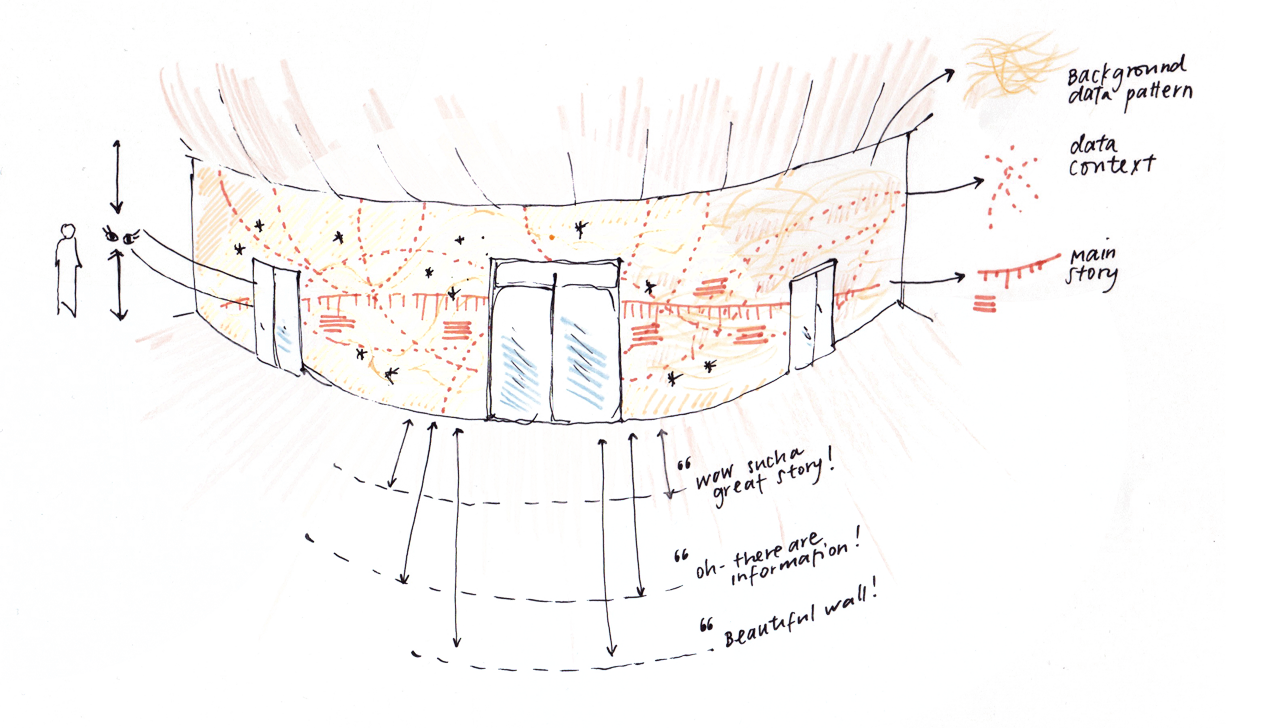
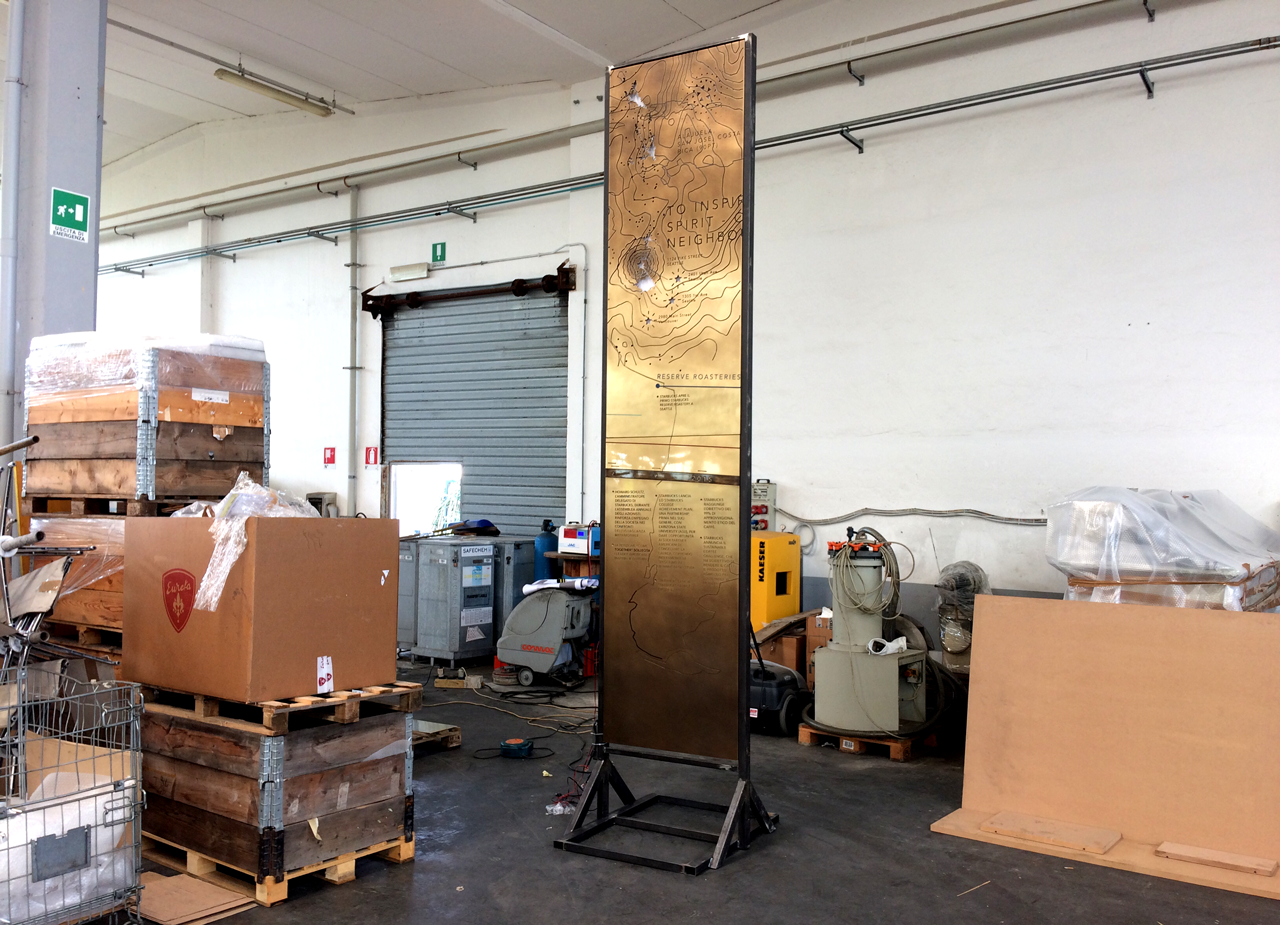
Work–in–progress panels.
Solution
Despite the many attractions of the Roastery, the eye is immediately drawn to the installation: a multi–layered, illustrated history rendered in brass by local artisans with local materials. The richly detailed mural invites users to explore with their eyes and dive deeper with their devices, via an AR app that unlocks a hidden layer filled with imagery and animations.
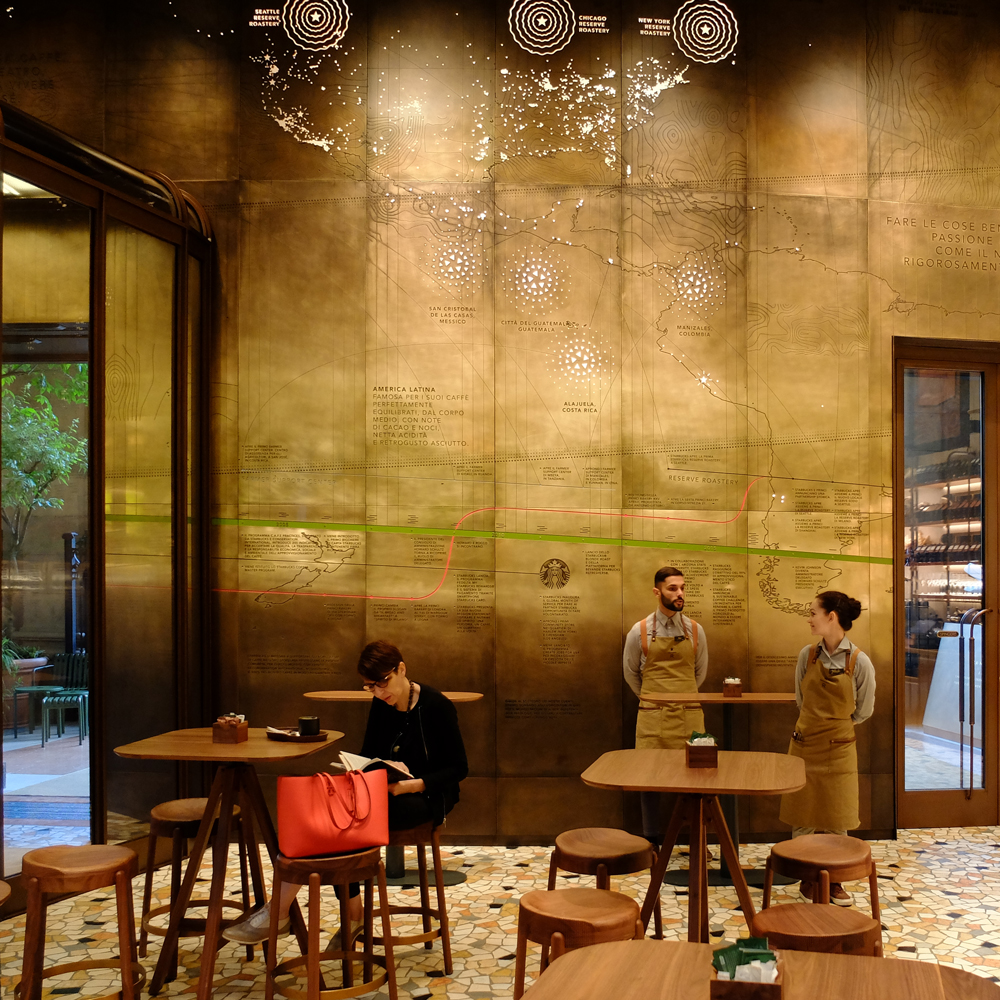
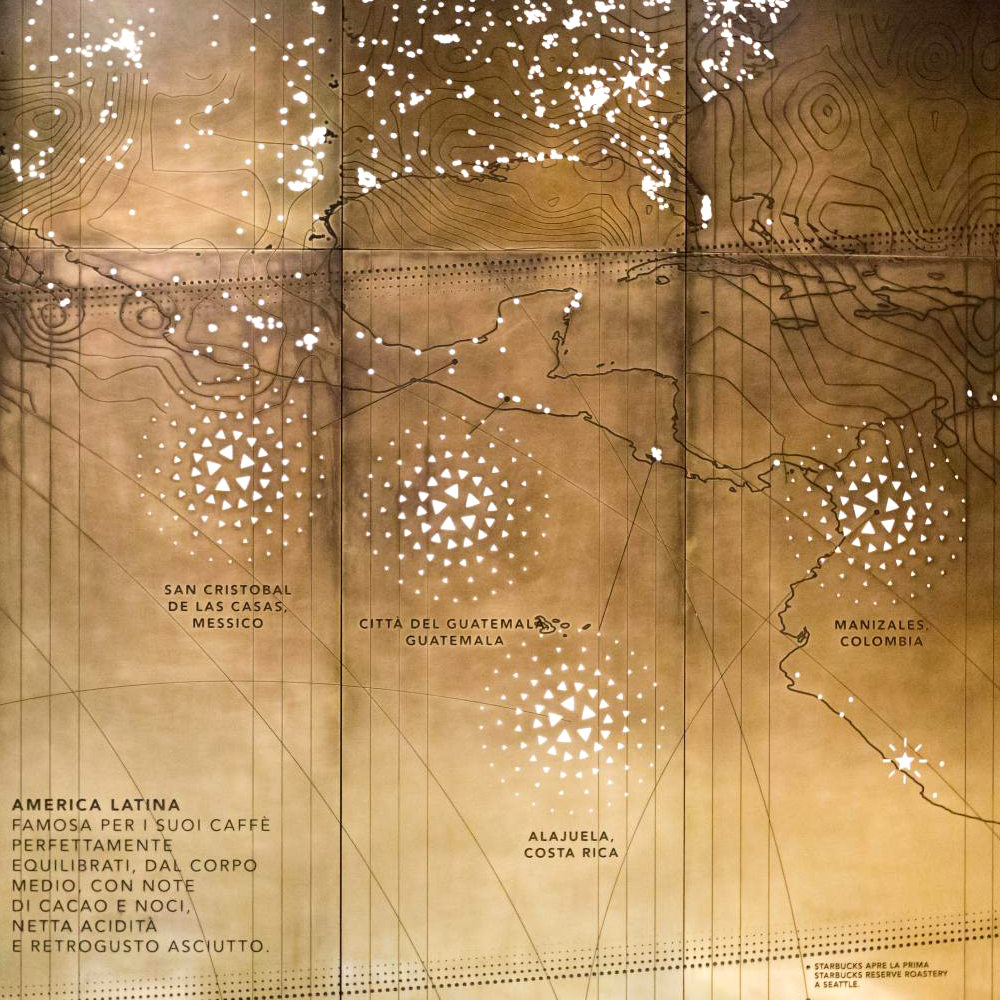
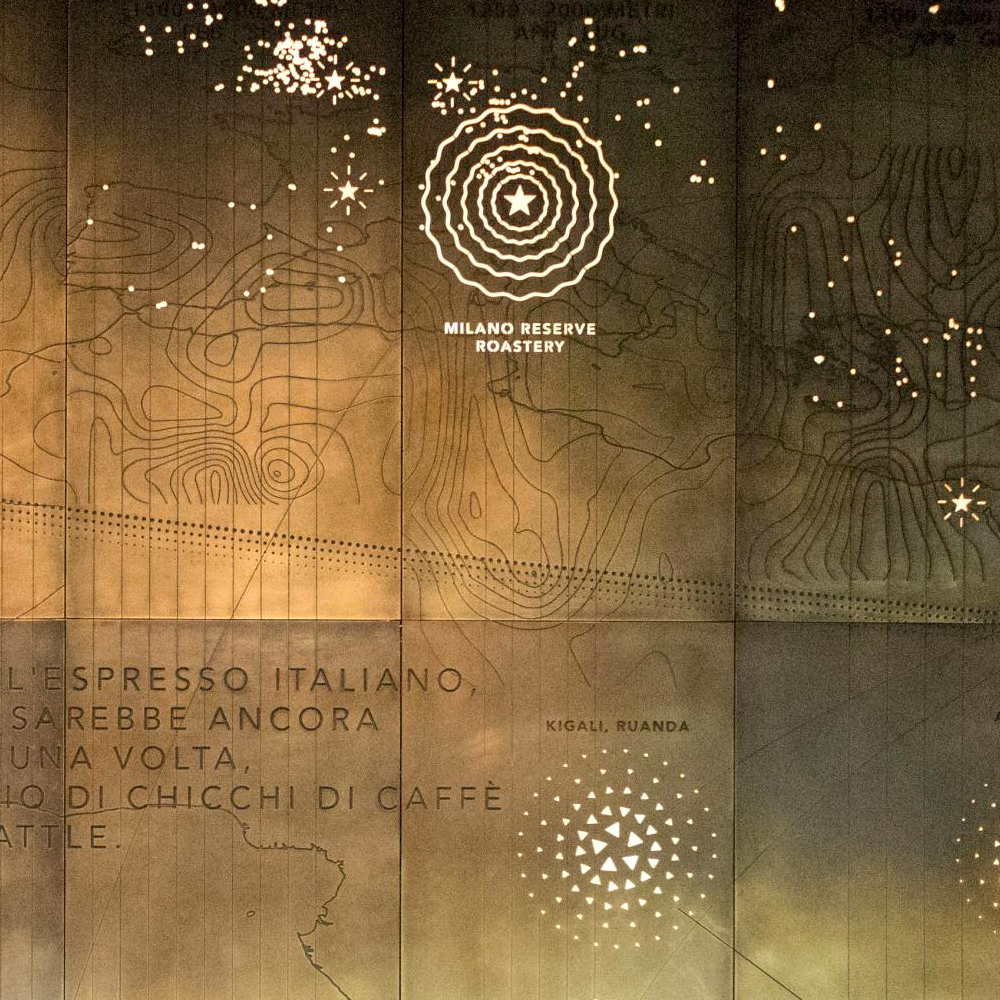
The wall is composed of three layers. In addition to a main narrative timeline that relays the story of Schultz' fateful trip to Italy, we incorporated cartographic components to highlight places integral to the company's history and culture. Each layer is distinguished by its engraving technique and lighting treatment.
The AR app adds yet another, digital layer to the experience, transforming the wall into an interactive artwork. With the app, users can access bonus materials that provide more information on the Milan Roastery, or, alternatively, transport them to partner farms and/or coffee–centric locales around the world. Accessible via markers throughout the Roastery, the app encourages active exploration of the entire space.
The AR app adds yet another, digital layer to the experience, transforming the wall into an interactive artwork. With the app, users can access bonus materials that provide more information on the Milan Roastery, or, alternatively, transport them to partner farms and/or coffee–centric locales around the world. Accessible via markers throughout the Roastery, the app encourages active exploration of the entire space.
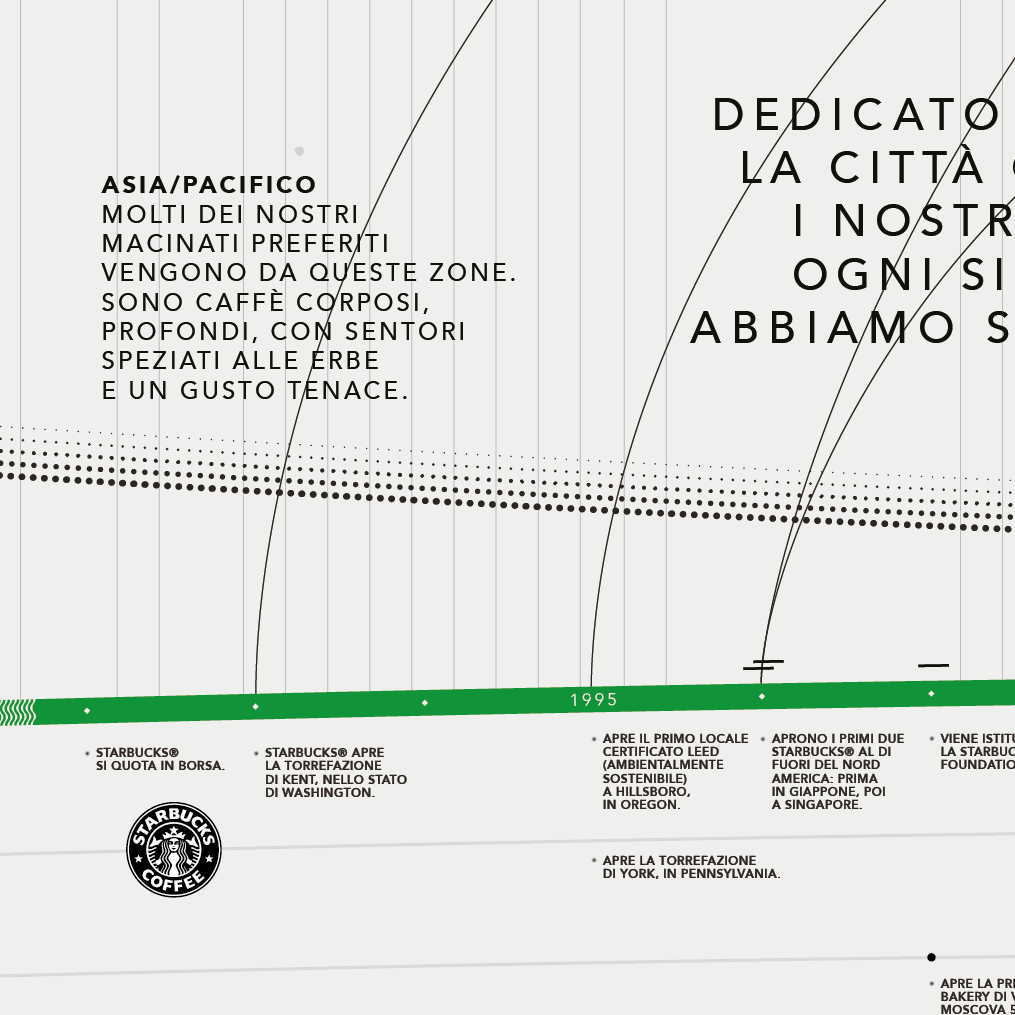
AR Layer 1: A timeline that marks important events in the brand's history, from its founding to its latest Milan location.

Layer 2: A map showing Starbucks locations, Reserve Roasteries, pivotal places in the brand's trajectory, and areas where sourced coffee beans are grown.
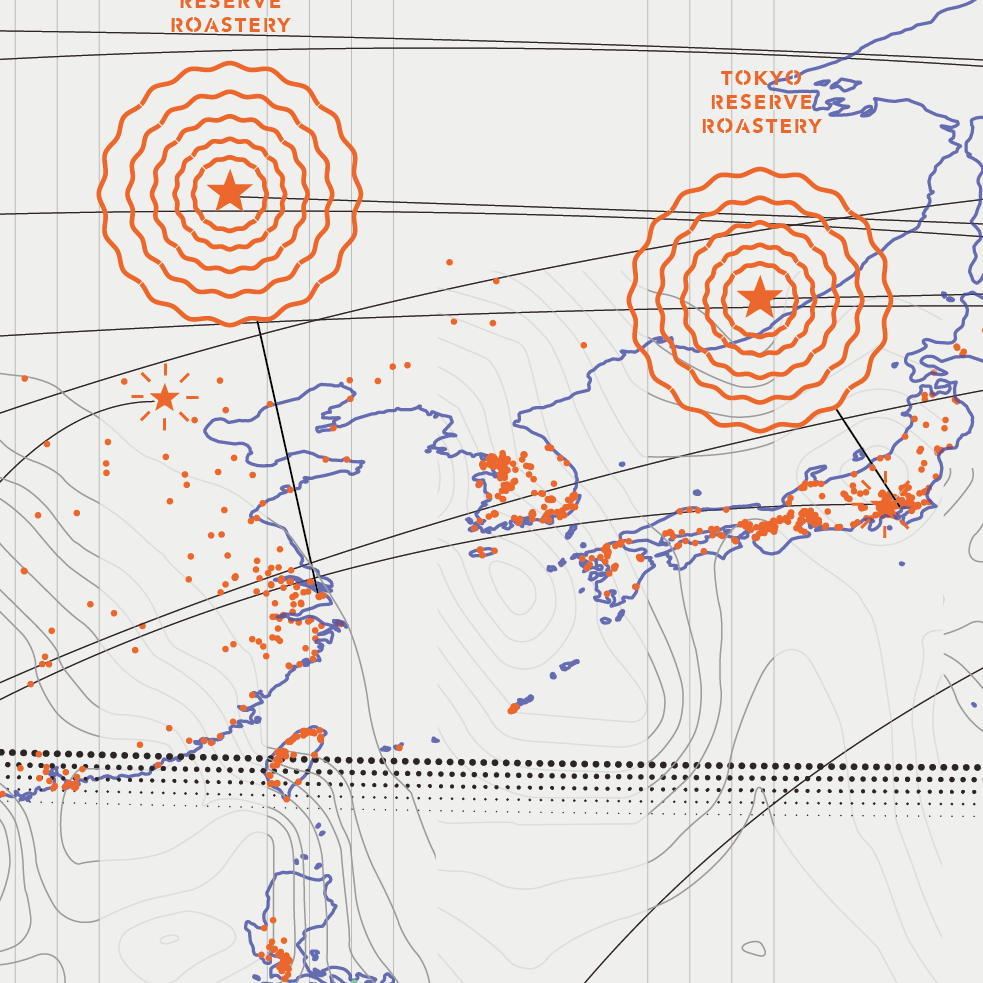
Layer 3: Another map illuminating where coffee beans are farmed, with visualizations to denote altitudes and harvesting seasons.

Results
Business Insider opined that the Milan Reserve Roastery might be Starbucks' “most beautiful store to date.” Our data wall greets visitors near the entrance of the 25,000–square–foot space and acquaints them with its special role in Starbucks' evolution. Our contribution relays a story that came full circle with the Roastery's opening.
Team
Elena Aversa
Marco Bernardi
Giacomo Flaim
Stefania Guerra
Giorgia Lupi
Giovanni Magni
Simone Quadri
Gabriele Rossi
Elisa Spigai
Tommaso Zennaro
Andrea Bassan
Davide Berretta
MONOGRID
Starbucks Creative Global Design and Innovation
Services
Data Art
Physical Installation
Augmented Reality Experience
Dataviz, Experience, WebApp, and Mobile App Design